Ethereum, a widely adopted platform for smart contracts and decentralized applications, sometimes faces challenges like slow transaction speeds and high costs during periods of high activity. To overcome these limitations, solutions like Arbitrum have emerged, offering enhanced scalability.
Arbitrum and similar layer 2 scaling solutions provide faster transaction speeds and lower fees, making Ethereum more efficient and cost-effective for users. By adopting these solutions, Ethereum can address its scalability concerns while maintaining its security and decentralization. These advancements contribute to the continued growth and success of Ethereum as a leading platform in the decentralized application space.
Introduction
Arbitrum is a Layer 2 scaling solution designed for the Ethereum blockchain. It aims to enhance the speed and cost-effectiveness of smart contract transactions.
Layer 2 solutions work by offloading complex computational tasks, such as transaction processing and data storage, to a secondary chain. In this case, the Layer 2 blockchain executes the smart contract, while the Layer 1 blockchain stores the associated data. This approach allows for improved scalability and reduced congestion on the Ethereum mainnet.
By leveraging Arbitrum, projects in the decentralized finance (DeFi) space, such as Sushiswap and AAVE, can offer more efficient swaps with lower gas fees. Arbitrum handles the transaction processing and batching, resulting in a smoother user experience and reduced costs compared to the Ethereum main network.
How Does Arbitrum Work?
Arbitrum’s Layer 2 solution improves transaction efficiency by using a technique called blockchain rollups. Rollups process transactions off-chain and then settle them on the main blockchain. This approach reduces the burden on the blockchain, as it only needs to confirm batches of transactions instead of each transaction individually.
Arbitrum’s scaling solution, known as optimistic rollups, relies on the security of the main blockchain to ensure the integrity of transactions. This makes it different from other Layer 2 solutions that operate independently.
What is an Optimistic Rollup?
Optimistic roll-ups use a clever approach to process transactions off-chain and bundle them together more efficiently. By compressing the data and storing only essential information on the Ethereum blockchain, optimistic roll-ups help reduce gas fees and optimize block space. This means that more transactions can be processed on the main chain without taking up too much space.
The key idea behind optimistic rollups is to assume that most transactions are valid, and only verify them when there is a dispute. Participants in the network have the ability to raise disputes if they detect any faulty blocks within a week. If a validator is found to have approved faulty blocks, they will lose their collateral. However, because of the complex fraud detection process, withdrawals from the rollup chain can take up to a week to process.
Who Created Arbitrum?
Arbitrum is developed by Offchain Labs, a New York-based company founded by Ed Felten, Steven Goldfeder, and Harry Kalodner. These founders are former researchers from Princeton University with extensive knowledge in computer science, cryptography, and blockchain technology. Ed Felten, a computer science professor at Princeton and former Deputy CTO of President Obama, serves as the Chief Scientist of Offchain Labs. Steven Goldfeder, who holds a Ph.D. from Princeton, is the CEO of the company. Harry Kalodner, also pursuing a Ph.D. at Princeton, takes on the role of CTO.
In 2021, Offchain Labs announced a successful Series B funding round, raising $120 million. The funding was led by Lightspeed Venture Partners, valuing the company at $1.2 billion. Notable investors such as Polychain Capital, Pantera Capital, and Mark Cuban also participated in the funding. This financial support has provided Off Chain Labs with the resources needed to further develop and advance the Arbitrum ecosystem, reinforcing its position as a prominent player in the blockchain industry.
Arbitrum’s Growth
Since its launch, Arbitrum has garnered remarkable traction as one of the most sought-after layer 2 solutions on the Ethereum network. In a recent milestone, the network achieved a staggering 1.103 million transactions, surpassing Ethereum’s own transaction count of 1.084 million on the same day. Furthermore, Arbitrum boasts an impressive Total Value Locked (TVL) of $1.68 billion, solidifying its position as the leading layer 2 network in terms of TVL. With its growing popularity and strong performance, Arbitrum is quickly establishing itself as a top choice for users seeking enhanced scalability and efficiency on the Ethereum blockchain.
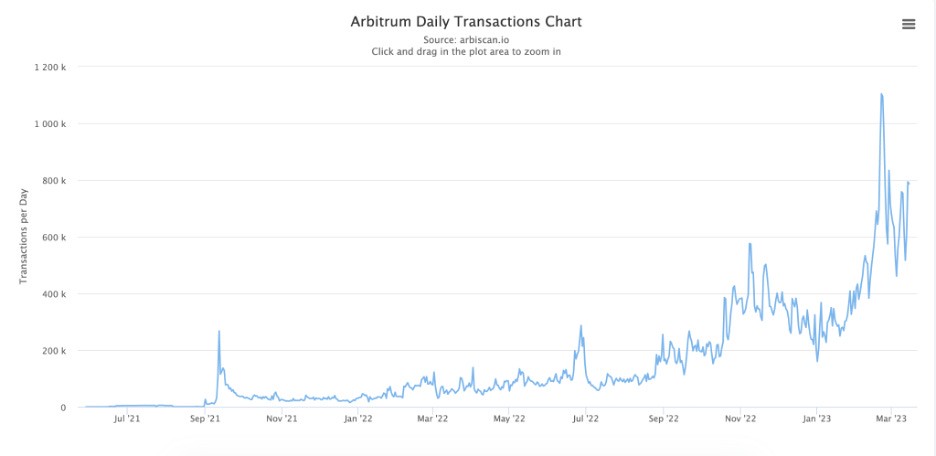
Highest number of 1,103,398 transactions on Tuesday, February 21, 2023. Source: Arbiscan
Additionally, the number of unique addresses on the Arbitrum network has witnessed a remarkable surge, surpassing 3.4 million as of mid-March 2023.
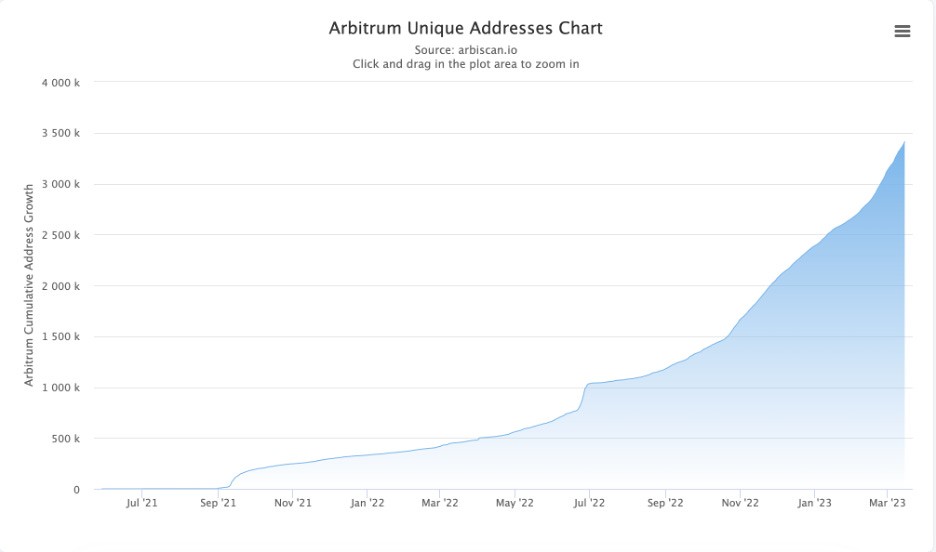
Arbitrum addresses had a daily increase of 24k on March 15. Source: Arbiscan
In March alone, more than 4,000 contracts have been deployed on the Arbitrum network, demonstrating the active development and utilization of smart contracts on the platform.
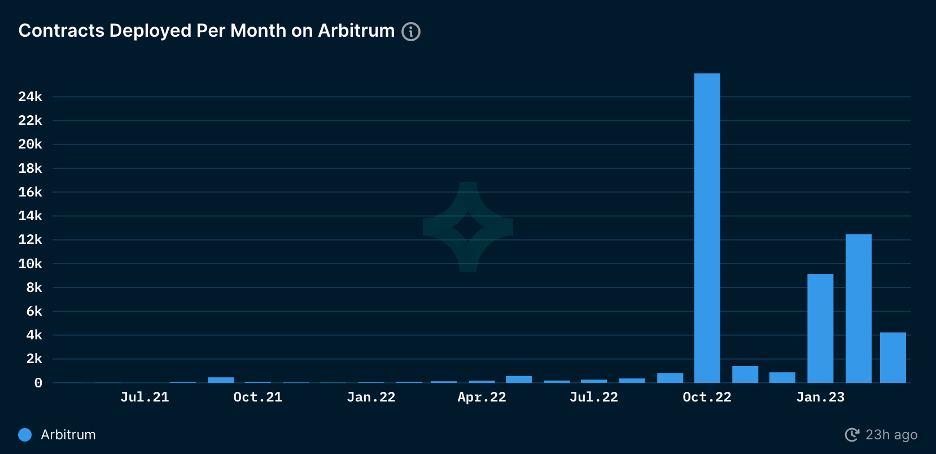
Source: Nansen
The Arbitrum Ecosystem
The Arbitrum ARB ecosystem operates through four essential components that work together to ensure its functionality:
1. Verifier: The Verifier is a distributed protocol that verifies and validates transactions on the Arbitrum network. It plays a crucial role in approving and disseminating verified transactions.
2. Key: The Key is a participant in the protocol responsible for managing funds and initiating transactions. It uses a public key’s hash as identification and signs transactions with the corresponding private keys.
3. Virtual Machine (VM): The VM stores data and code that define its actions within the Arbitrum protocol. Arbitrum utilizes its customized VM architecture called the Arbitrum Virtual Machine (AVM). The VM is managed by a group of Managers assigned by the VM’s creator. These Managers monitor the VM’s progress, ensuring it operates as intended. They help verifiers advance the VM’s state at a lower cost and resolve conflicts using the bisection technique.
4. Manager: Managers are responsible for overseeing the VM’s functioning and ensuring it meets expectations. They facilitate efficient cooperation between verifiers and help resolve disputes between Managers. They also play a role in selecting candidates for managerial roles and imposing reasonable constraints on the group of Managers.
The collaboration between these components allows Arbitrum to provide a scalable, secure, and cost-effective solution for Ethereum-based DApps. The system optimizes resource usage by requiring verifiers to verify the hash of the VM rather than its full state. In cases of disagreement, the bisection process ensures fair conflict resolution. This combination of components and processes enables Arbitrum to enhance the scalability and efficiency of decentralized applications built on the Ethereum network.
The ARB Token
The ARB token is an important part of the Arbitrum ecosystem, serving as the governance token for decentralized decision-making through the network’s DAO. It allows token holders to participate in shaping the platform by proposing and voting on changes to the core code. This shift towards decentralized governance empowers community members to contribute to the development and operation of Arbitrum, ensuring its competitiveness and adaptability in the rapidly evolving world of layer 2 scaling solutions.
With the introduction of ARB, decentralization within the Arbitrum ecosystem is strengthened, enabling the platform to better address the needs and preferences of its community. Through the Arbitrum DAO, token holders can vote on critical matters such as technology upgrades, revenue allocation, and core protocol-level decisions. By distributing ARB tokens to eligible community members through an airdrop, Arbitrum aims to foster greater community engagement and ensure that the platform’s future aligns with user values.
As the Arbitrum ecosystem continues to grow, the ARB token will play a crucial role in shaping its trajectory, ensuring that the platform evolves in line with the aspirations and interests of its users.
Arbitrum (ARB) Tokenomics
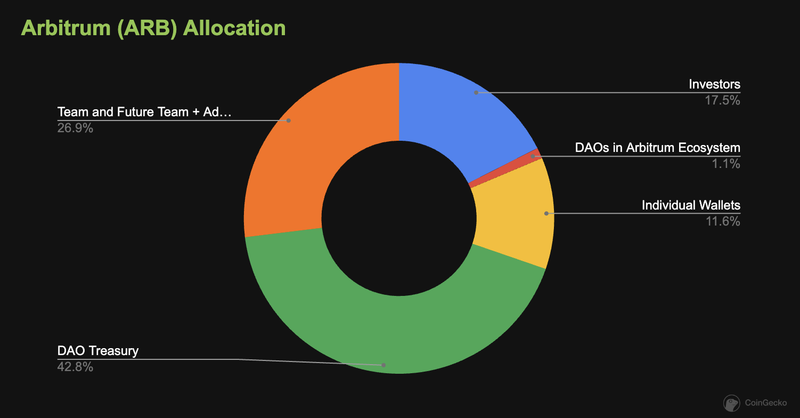
Source: CoinGecko
The distribution of Arbitrum (ARB) tokens is as follows:
- 17.53% is allocated to Investors.
- 1.13% is allocated to DAOs in the Arbitrum Ecosystem.
- 11.62% is allocated to Individual Wallets.
- 42.78% is allocated to the DAO Treasury.
- 26.94% is allocated to the Team, Future Team, and Advisors.
It is important to note that on 23 March 2023, according to the Arbitrum website, there will be an airdrop of 12.75% of the total ARB token supply. Out of this, 11.62% will be allocated to users, and 1.13% will be allocated to DAOs. The initial supply of ARB tokens is 10 billion.
Conclusion
Arbitrum has emerged as a highly promising layer-2 scaling solution for the Ethereum blockchain. It offers faster transaction speeds, lower fees, and enhanced scalability, addressing some of the limitations faced by Ethereum during periods of high activity. With its innovative approach, Arbitrum has gained significant traction, surpassing Ethereum’s transaction count and boasting a high Total Value Locked (TVL) of $1.68 billion. The platform’s growth is further supported by the active deployment of contracts and the increasing number of unique addresses on the network.
By leveraging the power of the ARB token and embracing decentralized governance, Arbitrum is empowering its community to contribute to the platform’s development and shape its future. As Ethereum continues to evolve, Arbitrum’s role in providing a more efficient and cost-effective solution for decentralized applications remains pivotal, solidifying its position as a leading player in the blockchain industry.
